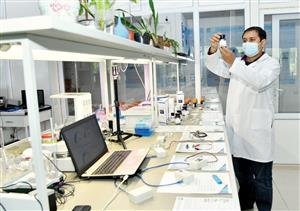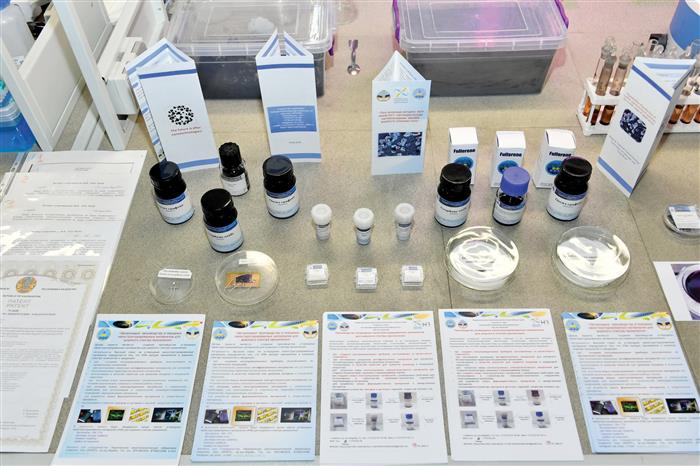- Main page
- News
FULLERENES ARE A WONDERFUL MOLECULE
3/24/2022
Scientists of the Faculty of Physics and Technology of Al-Farabi Kazakh National University are implementing the project "Organization of production of a wide range of carbon nanostructured materials." Nanomaterials are a new topic today. Due to its wide range of applications, it is dominated by both interest and demand in the world. And what are the goals of our scientists through the implementation of this project? What is the effectiveness of this project? Today, with the participation of the project manager Daniyar Ismailov, we would like to introduce readers to this research work.
“Our main goal is to launch low-cost efficient production of carbon nanostructures (fullerenes) to create quality products with improved composition and properties. Carbon nanoscale molecular structures are called fullerenes. They have a general formula Cn. Here n usually takes the values 60 or 70. It has special physical and chemical properties, ”Daniyar Ismailov said. He is a candidate of technical sciences, PhD and a specialist of the National Open Nanotechnology Laboratory at our university.
According to the young scientist, fullerenes can be used in various fields. Especially in Kazakhstan's mining, oil and gas, metallurgy and geological-mineralogical industries, construction companies and electrical engineering, as well as pharmaceuticals, etc. areas. You know what carbon is. Basically, solid material, for example, can be obtained from diamonds. Carbon nanomaterials include fullerenes (C60, C70), graphenes and graphene oxide.

What is Fullerene?
Fullerene is a new material of great interest in the two-correlation system and in the scientific community. This is the third known stable molecular structure of carbon. It can be spherical, elliptical, tubular or annular. It was discovered by accident in 1985. This is a new structure, very stable carbon molecules. In fact, they are known as the third stable molecular form of carbon after diamond and graphite.
Fullerenes developed as a result of experiments with carbon molecules. Conducting research on the basis of these materials and continuing them on a regular basis will improve the current technologies for the production of useful materials for the future. The properties of fullerenes are special, especially the lubricating properties. Gives weak intermolecular strength for lubrication. Its molecules can condense to form a solid with stable and weak bonds. This solid is known as fullerite. If we bring the fullerenes to a very low temperature, we see that they are able to sublimate without losing the ball name. Its molecules are very electronic and form bonds with electron-donating atoms.
Strengthens the structure of the product
"We can see and touch micromaterials, but nanomaterials are different. We work with them at the level of DNA, atom, nucleus, so we see it under a microscope. Their structure is different. Much better, stronger. In short, it helps to improve the properties of any material and, consequently, its quality. May not be as interesting as raw. It is used in cement, paints, biomedicines, electronics, etc. When added, its properties are strengthened. For example, ordinary, existing cement can be punctured by precipitation. And the product with nanomaterial does not absorb water. Because of their small size, they are compact and durable. This means that the enriched products used in construction will last a long time due to their high quality and strength, ”Daniyar Ismailov said. Therefore, the composition and quality of products with the addition of nanomaterials will be enriched. This project is worth it.
Thus, nanomaterials, in particular: graphene, carbon nanotubes and fullerenes, due to their excellent electrical properties, make electronic devices promising everywhere, in the existing field, increasing its service life and efficiency. For example, if you add to the production of capacitors, current collectors, batteries and sensors, their quality will increase, and their service life will be extended. The cost of such devices is also much cheaper than imported products, as spare parts can be found and serviced. As a local product, you can quickly replace or upgrade both the device and the interface update.
The scientist noted another property of fullerenes: it can also be used as a fat additive.
- For example, let's take a car tire. Because of the constant rotation, some parts of the car have to be replaced from time to time. This is because the metal rubs against each other and wears out over time. And if we add a mixture of nanomaterials to that oil, for example, the metal is lubricated and its small holes are closed. As a result, the service life of tires and spare parts will be extended, - said Daniyar Ismailov.
Specialists of the National Open Nanotechnology Laboratory have improved the technology of obtaining fullerenes in the laboratory and obtained raw materials. "Fulleren's shape is like a soccer ball. It has a carbon atom on its edges. There are many types of fullerenes: C60, C70, C80, C90. The numbers here indicate the number of edges in the fullerene. This material has a wide range of applications. For example, you may have heard of carbon nanotubes. These tubes are made of the primary product of carbon - graphene, "said the young scientist.
Carbon is made up of atoms that form a hexagonal crystal lattice. And graphene is a layer of a similar lattice with a thickness of only one atom. So, its first special feature is that it is the thinnest material. Graphene is 300 thousand times thinner than a sheet of paper. Nevertheless, it is one of the strongest materials. Because the bonds between the carbon atoms are strong. Now, when those atoms are shaped into a ball, a fullerene is produced.
- As for the technology of fullerene production. With the help of special equipment in the laboratory, we burn a graphite rod and get ash from it. The process is carried out in a vacuum and we use an inert gas - helium. Ash also contains carbon. It is porous and micromaterial. And we produce a single and nanoscale material from it. As mentioned above, it is not the ash itself that is important, but its carbon nanotubes, graphene and fullerene. In the second level, with the help of solvents, we clean the ash and separate the substances. As a result, after several chemical stages, the finished product - fullerene is released, - says Mr. Daniyar.
The product is currently on the market. "But the pandemic has affected our plans as well," he said. Currently, there are requests from Russian manufacturers. Since the domestic market is not yet fully ready to use such products, the export of fullerene would be more profitable. The first steps have been taken for this. For example, the scientist said that he had received proposals for the use of construction materials from Moscow and Tomsk, but did not hide his hopes for the future of the project.
KAMILA DUYSEN

